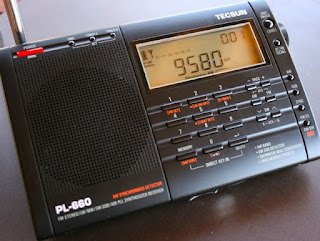Over recent months, John Bissel's WORKBENCH column with Radio World Magazine has been
sharing different readers ideas of what constitutes a useful "GO-BoX" for onsite upgrade and repair work. In amateur radio, most Field Day and CERT operations utilize variations on the GO-Box theme.
As a traffic handler and radiosport operator, whenever possible, I always make thorough equipment checks a day or two prior to an upcoming event: the equipment locally, as well as any station equipment I will be running remotely. Even with all those precautions, "little" things can and
will go wrong that disrupt a smooth operating flow.
What at first looks to be a pile of junk or bunch of toys, is actually a carefully acquired set
of implements designed to further the response to the different things which routinely occur
during operating events.
Over the last couple of years, I have accumulated a useful pile of "trinkets" which adorn the
upper-left area of the clear plexiglass covered operating desk. The largest most prominent item
is the 8 1/2" x 11" white tablet I wrote the notes for this Blog on.
Throughout a radiosport contest weekend, various things occur during the operation that are often
"So bizarre" I am compelled to jot a bullet-item or even a paragraph regarding what just happened. Frequently these blurbs evolve into contest blog segment pieces themselves or even an entire Blog series as happened recently with the Revised Radiosport Rules post ([CLICK HERE]) published
in June. Underneath the BiG PaD is a smaller 5" x 8" pad for jotting down relevant callsigns and
frequencies during the seemingly near-chaotic operation in progress.
"So bizarre" I am compelled to jot a bullet-item or even a paragraph regarding what just happened. Frequently these blurbs evolve into contest blog segment pieces themselves or even an entire Blog series as happened recently with the Revised Radiosport Rules post ([CLICK HERE]) published
in June. Underneath the BiG PaD is a smaller 5" x 8" pad for jotting down relevant callsigns and
frequencies during the seemingly near-chaotic operation in progress.
The majority of the "tools" in the above picture are more-or-less self-explanatory in their use,
although some may need more of an explanation.
- The cosmetic brush allows a quick Swoosh away of crumbs and dust on the keyboard.
- The half-open paper clip is used to diddle reset buttons on the back of equipment units
that occasionally need a last resort reset. - A (double-female) audio connector block enables trying out an audio configuration
or path that presents itself in a given situation. It is supplanted by a USB-powered
4-channel mini mixer, offering more than JUST ground loop isolation. - A Harbor Freight freebie flashlight, making for easier front panel adjustments under marginal lighting conditions (I HATE bright, overbearing lighting).
- 3 styles of screwdrivers for last minute whatever-adjustments.
- Tweezers and Forceps for picking up and holding little screws/nuts.
- A lighted dollar store magnifying lens.
Underneath the clear plexiglass are frequency lists, zone lists and Q-Code lists
that may be needed during a typical operating event.
that may be needed during a typical operating event.
Some things belong in BOTH the HERE-KiT and THERE-KiT.
In particular is a pair of OWN-Zone Wireless stereo headphones ("as seen on TV").
I can use one set (for up to 3-hours) while the other set is charging, or the 2nd-set can be
worn by a guest in the shack attempting to understand the insanity of radiosport operating.
I have evaluated numerous headset combinations, most of which turn out NoT to be stereo,
(required when running Stereo-CW, for example) - the main reason I still use OWNZONE.
In particular is a pair of OWN-Zone Wireless stereo headphones ("as seen on TV").
I can use one set (for up to 3-hours) while the other set is charging, or the 2nd-set can be
worn by a guest in the shack attempting to understand the insanity of radiosport operating.
I have evaluated numerous headset combinations, most of which turn out NoT to be stereo,
(required when running Stereo-CW, for example) - the main reason I still use OWNZONE.
My THERE-KiT is essentially a bag of cables, filters and other units that may be needed at
almost any location I happen to operate from. Included in the THERE-Kit are the following:
almost any location I happen to operate from. Included in the THERE-Kit are the following:
- Install files for WQ6X Beacon Tracker & EASY-Button software as well as
SNAP-Shot screenshot software. - 2-pair of OWN-Zone headphones as well as a WIRED stereo headset.
- a generic electret microphone with adapter cables to fit most transceivers.
- a CW Keying paddle with a pair of adapter plugs.
- a PL-600 SW receiver for checking propagation and RFI sources.
- a LEKATO JA-02 II Bluetooth stereo speaker unit (1 or 2).
- a USB-powered 4-channel audio mixing unit.
- a USB-drive for moving files on/off the operation computer.
- a set of 4-each A-A and A-A-A batteries.
- Several 1/8" stereo patch cables.
- an EASY Button.
Whether a HERE-KiT or THERE-KiT, the important thing is to think it through well in advance of when you might actually need it. Then, as you learn from experience, you can update/upgrade the kits as the need arises. KiTs are like an insurance policy - you hope you never need it and then are thankful in retrospect for having everything more-or-less easily at hand.
Have YOU put together a HERE-KiT and THERE-KiT?
If NoT, WHY KNoT?

.jpg)





%20-%20STeReO%20-%20Triangular.Jpg)


No comments:
Post a Comment